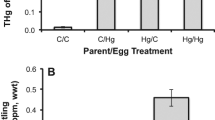Summary
Mallard ducks were fed a control diet or a diet containing 0.5 or 3 ppm mercury (as methylmercury dicyandiamide) based on the dry feed. These mercury diets are approximately equivalent to 0.1 and 0.6 ppm mercury in a natural succulent diet. I measured for the ducklings the approach behavior in response to a tape-recorded maternal call and the avoidance of a frightening stimulus.
There were no significant differences among controls and ducklings from mercury-treated parents in the percentage of ducklings that approached the tape-recorded call. Control ducklings, however, moved back and forth toward the call more than ducklings from mercury-treated parents and also spent more time in the end of the runway near the loudspeaker than ducklings whose parents were fed a diet containing 0.5 ppm mercury.
Compared to control ducklings, ducklings from parents fed a diet containing 0.5 or 3 ppm mercury were hyper-responsive in the test of avoidance of a frightening stimulus.
Mallard eggs collected in the wild have been found to contain levels of mercury exceeding the 1 ppm (wet-weight) found in the eggs of hens fed a diet containing 0.5 ppm, but there are no reports of mallard eggs collected in the wild that were found to contain as much mercury (6 to 9 ppm) as eggs from hens fed a diet containing 3 ppm mercury. On a dry-weight basis, the concentration of mercury in the eggs was about 6 times as great as that in the feed for ducks fed the 0.5 ppm mercury diet and about 6 to 9 times as great for ducks fed the 3 ppm mercury diet.
Similar content being viewed by others
References
BORG, K., H. WANNTORP, K. ERNE, and E. HANKO: Viltrevy6, 301 (1969).
DILLON, JR., O. W.: Trans. N. A. Wildlife Conference24, 374 (1959).
DUNCAN, D. B.: Biometrics11, 1 (1955).
DUSTMAN, E. H., L. F. STICKEL, and J. B. ELDER: InEnvironmental Mercury Contamination. Edited by R. Hartung and B. D. Dinman. Ann Arbor: Ann Arbor Science Publishers, 46 (1972).
HEINZ, G.: Bull. Env. Cont. and Toxicol.11, 386 (1974).
KRAMER, C. Y.: Biometrics12, 307 (1956).
LAHUE, R.: Bull. Env. Cont. and Toxicol.10, 166 (1973).
LJUNGGREN, L.: Viltrevy5, 423 (1968).
McATEE, W. L.: Wildfowl food plants their value, propagation, and management. Collegiate Press, Inc.; Ames, Iowa. 141 p. (1939).
MARTIN, A. C. and F. M. UHLER: U. S. Dept. of Interior Fish and Wildlife Service Research Report 30, 308 p. (1939).
MEEKS, R. L.: J. Wildl. Management32, 376 (1968).
RICKETT, H. W.: Wisc. Acad. Sciences, Arts, and Letters20_, 501 (1921).
ROSENTHAL, E. and S. B. SPARBER: Life Sciences11, 883 (1972).
SPYKER, J. M., S. B. SPARBER, and A. M. GOLDBERG: Science177, 621 (1972).
VERMEER, K.: Trans. N. A. Wildlife and Natural Resources Conference36, 138 (1971).
VERMEER, K., F. A. J. ARMSTRONG, and D. R. M. HATCH: J. Wildl. Management37, 58 (1973).
Author information
Authors and Affiliations
Rights and permissions
About this article
Cite this article
Heinz, G. Effects of methylmercury on approach and avoidance behavior of mallard ducklings. Bull. Environ. Contam. Toxicol. 13, 554–564 (1975). https://doi.org/10.1007/BF01685179
Issue Date:
DOI: https://doi.org/10.1007/BF01685179




